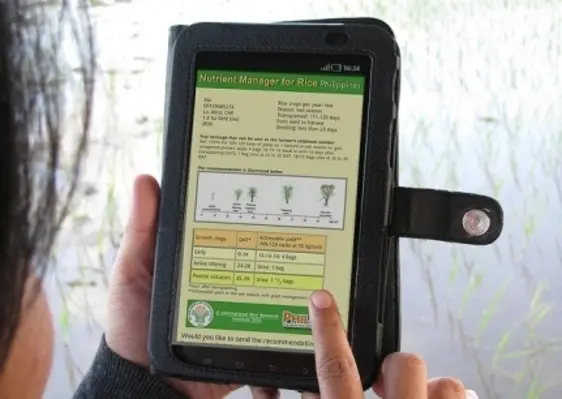Nutrient Manager for Rice Mobile (NMRiceMobile)—designed to give fertilizer guidelines to rice farmers via their mobile phones—is now available via smartphones with Android operating systems
Nutrient Manager for Rice Application (NMRiceApp) was launched recently at the Agricultural Training Institute (ATI) through the country’s Department of Agriculture, as a product of ongoing partnership with the International Rice Research Institute (IRRI).
“We wanted to make NMRice available on smartphones as a complement to existing Web and mobile phone applications of NMRice,” explains Dr. Roland Buresh, IRRI’s nutrient management expert and lead developer of NMRice. “NMRiceApp provides an additional way for rice farmers in the Philippines to obtain a fertilizer guideline for their crop.
“NMRiceApp has more capabilities than NMRiceMobile,” he adds. “For example, NMRiceApp provides a farmer with a fertilizer guideline adjusted for the farmer’s selected use of organic fertilizers.”
The application can be downloaded for free in the Android market by searching "NMRice Philippines." It was pretested in 2011 at three locations: La Paz, Tarlac; Oton, Iloilo; and Makilala, Cotabato.
Extension workers and farmers from these locations said that NMRiceApp was easy to use because of pictures and images that helped them understand questions.
The idea behind the use of smartphones and NMRiceApp is that farmers won't need to go to their towns or cities to get site-specific nutrient management advice via the Internet, especially when far from their farms.
By using NMRiceApp on their smartphones, extension officers can instead visit farmers, interview them, and store information on their smartphone. Once the smartphone is connected to the Internet, the extension officer can process the fertilizer recommendation for the farmer and send it to him or her via a text message.
"The beauty of this tool is it's become more powerful since it has greater capacity to process fertilizer recommendations comprehensively," cites Rowena Castillo, another IRRI nutrient management expert. "But, at the same time, it's also easily accessible since it's on a smartphone and an extension officer can take it to farmers in remote areas.
"Besides this, it makes the job of an extension officer easier and more convenient by ensuring that the fertilizer guideline provided to the farmer is based on up-to-date research," she adds.
With ATI's support, IRRI aims to further examine the potential of smartphones to reach farmers with fertilizer guidelines in eight partner municipalities through its cyber village project in the Philippines.
These municipalities are Apalit, Pampanga; Batac, Ilocos Norte; Infanta, Quezon; Victoria, Laguna; Dingle and Oton, Iloilo; Banay-banay, Davao Oriental; and Kabacan, Cotabato.
"Mobile phone applications like NMRice help the Department of Agriculture provide Filipino farmers with precision farming practices tailored to a farmer’s specific situation and needs," says Dr. Buresh.
Since its debut in the Philippines a year ago, NMRiceMobile has received more than 6,500 calls.





